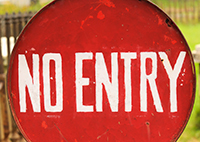Working remotely, you most likely go through an authentication process to connect to your company’s network using a dial-up or virtual private network, entering your username, password, and a changing code to gain access.
The same thing might happen when you access your bank account online—with your bank asking you for an account username and unique password. Many banks are already using smart card authentication, which provides stronger security than just a password. Smart card authentication ensures that a user is in physical possession of the card and must know the personal identification number. This proves it’s really you accessing your bank account.
Domain Authentication and authorization work together
But are your most business-critical domain names also as secure?
 Two-factor authentication is a security product designed to help protect your business-critical digital assets. It requires a special key that is used in conjunction with your username and password to access sensitive systems. With the choice of a soft (smart phone app) or hard (physical) token, you enter the changing key code when logging in, along with your username and password. If the keys match, the system knows it’s you, and you are granted access.
Two-factor authentication is a security product designed to help protect your business-critical digital assets. It requires a special key that is used in conjunction with your username and password to access sensitive systems. With the choice of a soft (smart phone app) or hard (physical) token, you enter the changing key code when logging in, along with your username and password. If the keys match, the system knows it’s you, and you are granted access.
Corporation Service Company® (CSC®) offers two-factor authentication to protect your brand. It prevents your business-critical domains names from unauthorized changes.
In addition to the authentication process, CSC also offers multi-layer authorization. MultiLock combines registry and registrar-level locks with three-party manual authorization and a WHOIS lock to provide the highest level of security for high-value domains. An important and valuable aspect of CSC MultiLock is that in order to make any changes, three independent parties must provide authorization. This manual 3 factor authentication between the domain owner, CSC, and the applicable registries significantly reduces the likelihood of a domain name being hijacked or pointed to third-party content by a hacker or unauthorized user.
Cybercrime is on the rise—prevent it from happening to you. To learn more about Domain Security and Registrar Lock Services, please visit our website.